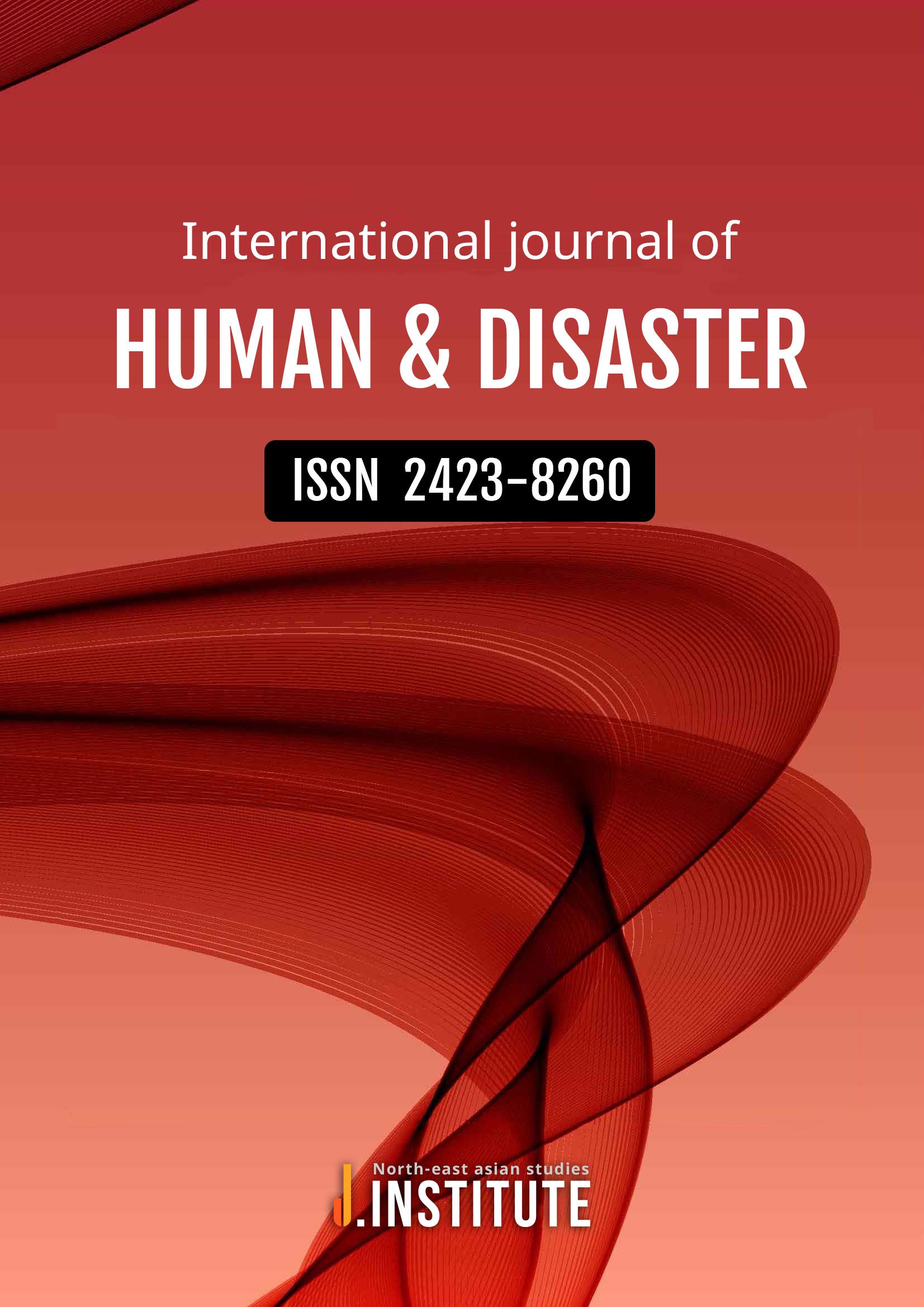Community interest in and demand for a safe society for humans, disasters, and peace of mind are increasing more rapidly. From this perspective, Humans and Disasters are closely related, and their impact on social values is interactive. The data on these things shows that understanding and respecting the importance of social values in disaster situations helps promote the resilience and sustainability of societies.
In the face of human catastrophe, social values are strengthening a sense of community, and forming a sense of solidarity as members of society become a culture, leading to moral choices about what individuals and groups value. Thus, culture and social values can provide creative ideas and approaches for problem-solving and new transformations in human life and behavior.
This journal looks at the diversifying social phenomenon from a human perspective, we want to take a reflective approach to reveal the story of the phenomenon as it is, and with deep interest in the problems of life. Has become a communication and it has grown into a shared, empathized, and communicated. Since the impact on human life is a problem that transcends borders, an international response is required, and research data are needed to achieve social balance by analyzing various phenomena that affect society through the improvement of human life quality. It not only reveals the existing phenomenon about the story within the phenomenon but also becomes a place where we can improve the problems of our lives and society, dealing with issues of social phenomena without prejudice, thinking about how society understands and what efforts to make.
Detail with a we recommend that potential authors review recent issues to determine whether their paper is appropriate to the journal.
Aims & Scope
Area 1 Human and Life
Area 2 Disaster
Area 3 Social Value
Latest Articles
+ View all articles
-
Purpose: The purpose of this study is to present a plan to respond well to disasters by using the Korean disaster safety communication network. The only well-established Korean disaster safety communication network in the world will be used to minimize damage to people's lives and property by exerting synergy between agencies dispatched to the disaster site by allowing various related agencies to respond to disasters in a linked manner. To ensure this, research should be conducted to make the best use of the Korean disaster safety communication net-work. Method: In order to suggest a way to make good use of the disaster safety communication network, research methods such as literature research, on-site inspection, and opinion collection were applied. The literature survey studied the actual state of domestic and foreign construction related to the disaster safety communication net-work, and the research method was applied so that the current state of use of the disaster safety deep-seated network could be confirmed through on-site surveys and opinion collection, and problems could be analyzed to suggest alternative measures. This is a research conducted in the direction of strengthening the field utilization of the disaster safety communication network. Results: As a result of the previous study, it was identified that the Korean disaster safety communication net-work has a well-established infrastructure and is partially utilized by disaster officials, but some of them are not properly utilized due to a lack of understanding of wireless communication between various organizations through group communication. To overcome this, communication procedures for group wireless communication should be established, disaster management should be performed using the disaster safety communication net-work, and disaster safety communication network training scenarios should be developed for each type of disaster so that they can be actively implemented. Conclusion: Once established, the disaster safety communication network is not complete in itself. In order for a well-established disaster safety communication network to function properly, it is necessary to develop a group wireless communication procedure for the disaster safety communication network and continue communication training in accordance with the developed communication procedure. To ensure this, continuous communication training should be conducted by actively utilizing the disaster safety communication network communication training scenario developed through this study. Since these efforts are not made in a moment, disaster management activities of disaster management officers should be established as a culture. Continuous and in-depth re-search should be continuously conducted to this end.Keyword:Disaster Safety Communication Network, Communication Procedures, Mutual Communication, Communication Training Scenarios, Professional Education
-
Purpose: In this study, the relationship between each factor and soil erosion is evaluated in order to simply approximate the amount of soil erosion and sediment runoff in small-scale watersheds or disaster impact assessments. Method: In this study, Linear regression analysis between soil runoff, soil erosion, and topographic factors results in the following criteria: curve number, flow length, bare soil percentage, sand composition ratio, 30-minute maxi-mum rainfall intensity, surface sand, maximum daily probability rainfall, and catchment area between Cor-relations were analyzed, and the relationship between soil runoff was analyzed and compared. Results: In the correlation analysis of soil erosion and soil runoff for each factor, it was analyzed that the correlation between the basin area and the slope was high. The results of the correlation analysis between the RUSLE equation and the factors did not show a high correlation. Conclusion: The regression equation presented in this study can be applied to the comparative re-view of the simple estimation and examination of soil runoff in small-scale disaster impact assessment.Keyword:Disaster Prevention, Debris Flow, Correlation, Soil Erosion, RUSLE
-
Purpose: Korean police officers play an important role in disaster situations through initial response, rescue and first aid for the injured, control and maintain order at the scene, traffic control, reporting and conveying in-formation, and using alternative communication methods. They also continue to influence the safety of residents after disasters by guiding citizens to evacuate, protecting vulnerable groups, and supporting recovery at the scene. As such, the police are important to the safety of citizens in disasters, and this study aims to explore the perception of disaster response and followership according to police rank and career path. Method: The data processing of this study was conducted using the statistical package program SPSS 23.0 Program, and statistical verification was performed as follows according to the purpose of data analysis. First, frequency analysis was conducted using the SPSS/PC+23.0 Program to identify general characteristics. Second, One Way ANOVA was conducted to identify differences in police disaster response awareness according to police rank and career path. Fourth, cross-analysis (Chi-Square) was conducted to identify the correlation between police rank and career path. Fifth, exploratory factor analysis was conducted to examine the followership of police organizations. Results: The higher the police rank, the higher the awareness of disaster response, and those who were police officer candidates had the highest awareness of disaster response. Rank and career path were statistically related, and the followership factors of police organizations were structured as ‘exemplary followership’, ‘creative followership’, and ‘active followership’. Conclusion: Followership of police is very important in disaster situations. The importance of followership in disaster situations is dealt with in various aspects such as rapid and efficient response of the organization, maintaining consistency and integration, conveying information and communication, managing stress and uncertainty, strengthening cooperation and teamwork, maximizing the effectiveness of leadership, and improving resilience after disasters. Through followership, police officers effectively support their superiors in disaster situations and play an important role in helping the entire organization achieve its goals.Keyword:Disaster Response Awareness, Police Officers, Ranks, Entry Paths, Followership
-
Purpose: Research on countermeasures against social disasters by analyzing the Itaewon disaster that shocked Korean society. Method: In order to study how to respond to social disasters considered as the Itaewon disaster, we analyze domestic laws and compare overseas cases. Results: Until the Framework Act on Disaster and Safety Management is revised to resolve legal issues for events without organizers, local governments should be responsible for planning, controlling, and safety. In addition, even if there is no organizer, the contents and risks of the event should be shared among related agencies and systematically responded by sharing roles through the "Regional Safety Management Committee" organized by the head of the local government under the law. Conclusion: The Itaewon disaster has many implications. It should be an opportunity to identify public safety problems such as crowd accidents and check social disaster response systems to move toward a properly established "Safe Korea" through revision of related laws and system and system maintenance.Keyword:Itaewon, Itaewon Disaster, Social Disasters, Crowd Management, Basic Act on Disaster and Safety Management Super Drugs
-
Purpose: A large-scale complex disaster refers to a disaster that develops on a huge scale outside the predictable range as natural disasters and social disasters occur serially or simultaneously. The local community must take into account the diversity of residents' situations and organize an evacuation cooperation system in advance in order to respond to such large-scale, complex disasters. The purpose of this paper is to present a direction for improving community response to disasters through a review of large-scale complex disasters. Method: This study examines the large-scale flood damage evacuation plan in the 5th district of Koto, Tokyo, Japan, which established an evacuation plan led by the local community after the Great East Japan Earthquake. Evacuation was divided into vertical evacuation, evacuating within the community, and wide area evacuation, evacuating outside the community. Results: The main features of these evacuation plans were that they encouraged local residents to make independent judgements, to implement the plans, and to proactively request and prepare for administrative support for the parts that were insufficient. Conclusion: First of all, for efficient evacuation from large-scale-complex disasters, various stakeholders need to be recognized and systematically organize, and cooperation with relevant and upper-level administrative agencies is needed to solve problems that are beyond the capacity of local governments. It is also necessary for residents to recognize their own role in disaster response along with the proper implementation of disaster prevention administration, and for the administration to support factors that residents cannot do as much as possible, as the basic structure of the crisis.Keyword:Large-Scale Complex Disasters, Community-Driven, Correspondence of Administration, Disaster Response, Evacuation Plan
Publishing Schedule
| JAN | FEB | MAR | APR | MAY | JUN | JUL | AUG | SEP | OCT | NOV | DEC | |
|---|---|---|---|---|---|---|---|---|---|---|---|---|
| Submission | 8/30 | |||||||||||
| Editorial Review | 9/10 | |||||||||||
| Double Blind Peer Review | 9/30 | |||||||||||
| Review-Form Reflection Review | 10/10 | |||||||||||
| Accepted | 10/20 | |||||||||||
| Manuscript Editing Review | 10/30 | |||||||||||
| Scientific Proofreading | 11/30 | |||||||||||
| Open & Hybrid Review | 12/10 | |||||||||||
| Published | 12/30 |
♦ Issues Per Year: Annual
Board Members
Head of Editorial Organization / President
Chongsoo Cheung
Soongsil University, KOR
[Curriculum Vitae]
General Vice President
Kibum Park
Kyungil University, KOR
[Curriculum Vitae]
Vice President
| Dongkwan Lee Planning and Coordination | Joongbu University, KOR |
| Soonsun Park Public Relations | Masan University, KOR |
Editor in Chief
Gutaek Bae
Masan University, KOR
[Curriculum Vitae]
Executive Editor
Sunggeun Kim
Chungang University, KOR
[Curriculum Vitae]
Editor in Administrations
| Abu Musa Mohammad Arif Billah | University of Dhaka, Bangladesh |
| Changsoo Kim | Sungkyul University, KOR |
| Greggory J. Favre | University of Maryland, USA |
| Hyeoncheol Moon | Soongsil University, KOR |
| Jaeyong Woo | Nagano University, Japan |
| Jeongbin Choi | Air Force Leadership Center, KOR |
| Jeumnam Kim | Howon University, KOR |
| Kathryn Haynes | University of Wollongong Australia, Australia |
| Monthinee Teeramungcalanon | Peking University, China |
| Morales Ana | Florida International University, USA |
| Nandintsetseg Sosorbaram | Soongsil University, KOR |
| Seungbum Ryoo | Soongsil University, KOR |
History
| 2015 | ||
| JUN. 23 | Establishment of the Publisher | |
| DEC. 05 | Inaugural General Meeting | |
| 2016 | FEB. 19 | International Journal of Human & Disaster (ISSN 2423-8260) |
| JUN. 30 | First Journal Publication | |
| OCT. 11 | Digital Object Identifier Enrollment (DOI) Google Scholar |
|
| 2019 | APR. 23 | EBSCO |
| MAY. 07 | ProQuest Exribris |
|
| 2020 | NOV. 02 | KCI (Korea Citation Index) |

Paper Submit
- inquiry@j-institute.org










